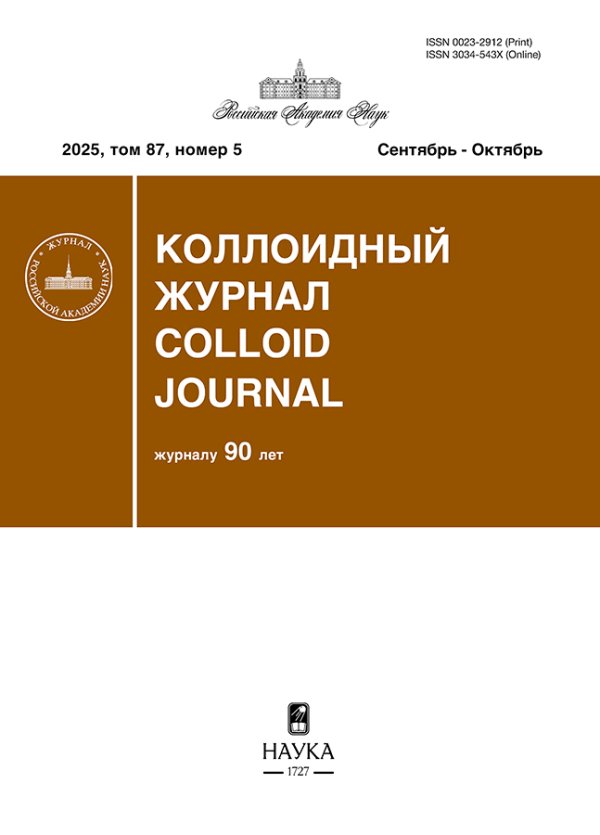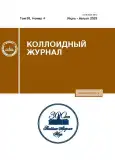EFFECT OF MAGNETITE CONTENT AND SPECIFICITY OF NICKEL(II) IONS ON ELECTROKINETIC PROPERTIES OF COMPOSITES BASED ON POROUS SILICA PARTICLES
- Authors: VOLKOVA A.V.1, LOPATINA E.S.1, SOLOVYEVA EV.1, ERMAKOVA L.E.1
-
Affiliations:
- St. Petersburg State University, St. Petersburg, Russia
- Issue: Vol 85, No 4 (2023)
- Pages: 410-423
- Section: Articles
- Submitted: 16.10.2023
- Published: 01.07.2023
- URL: https://journals.rcsi.science/0023-2912/article/view/137226
- DOI: https://doi.org/10.31857/S0023291223600323
- EDN: https://elibrary.ru/ALPSDK
- ID: 137226
Cite item
Full Text
Abstract
Powders of magnetite and its composites have been obtained on the basis of macroporous highsilica glass particles containing different amounts of Fe3O4. XRD, XPS, and Raman spectroscopy have been employed to confirm the formation of a magnetite phase in all iron-containing samples. The surface morphology and elemental composition of porous composite particles have been studied by SEM and EDX methods. It has been found that the external surface of porous silica particles is modified to different extents. It has been shown that the positions of the isoelectric point (IEP) and the values of the zeta-potentials for the composites coincide in indifferent electrolyte solutions. Two isoelectric points are observed in the pH dependences of the zeta-potential for the composite particles in nickel chloride solutions. In dilute solutions containing specifically adsorbed nickel ions and at pH values pHIEP-2, the electrokinetic properties of the composite particles are primarily affected by magnetite phase content in a composite powder and, at rather high concentrations of Ni2+ ions, by their specificity with respect to oxide surfaces.
About the authors
A. V. VOLKOVA
St. Petersburg State University, St. Petersburg, Russia
Email: anna.volkova@spbu.ru
Россия, 199034, Санкт-Петербург,
Университетская наб. 7-9
E. S. LOPATINA
St. Petersburg State University, St. Petersburg, Russia
Email: anna.volkova@spbu.ru
Россия, 199034, Санкт-Петербург,
Университетская наб. 7-9
E V. SOLOVYEVA
St. Petersburg State University, St. Petersburg, Russia
Email: anna.volkova@spbu.ru
Россия, 199034, Санкт-Петербург,
Университетская наб. 7-9
L. E. ERMAKOVA
St. Petersburg State University, St. Petersburg, Russia
Author for correspondence.
Email: anna.volkova@spbu.ru
Россия, 199034, Санкт-Петербург,
Университетская наб. 7-9
References
- Feijoo S., González-Rodríguez J., Fernández L. et al. Fenton and photo-Fenton nanocatalysts revisited from the perspective of life cycle assessment // Catalysts. 2020. V. 10. № 1. P. 23. https://doi.org/10.3390/catal10010023
- Shariatinia Z., Esmaeilzadeh A. Hybrid silica aerogel nanocomposite adsorbents designed for Cd(II) removal from aqueous solution // Water Environment Research. 2019. V. 91. № 12. P. 1624–1637. https://doi.org/10.1002/wer.1162
- Kondrashova N.B., Shamsutdinov A.S., Batueva T.D. et al. Preparation and properties of iron oxide doped mesoporous silica systems // Journal of Inorganic and Organometallic Polymers and Materials. 2020. V. 30. P. 2081–2088. https://doi.org/10.1007/s10904-019-01370-2
- Viter R., Geveluk S., Smyntyna V., Doycho I. Optical properties of nanoporous glass filled with TiO2 nanostructures // Optica Applicata. 2012. V. XLII. № 2. P. 307–313. https://doi.org/10.5277/oa120208
- Zapotoczny B., Dudek M.R., Guskos N. et al. FMR study of the porous silicate glasses with Fe3O4 magnetic nanoparticles fillers // Journal of Nanomaterials. 2012. V. 2012. P. 341073. https://doi.org/10.1155/2012/341073
- Burak Ertuş E., Vakifahmetoglu C., Öztürk A. Enhanced methylene blue removal efficiency of TiO2 embedded porous glass // Journal of the European Ceramic Society. 2021. V. 41. № 2. P. 1530–1536. https://doi.org/10.1016/j.jeurceramsoc.2020.09.047
- Мазурин О.В., Роскова Г.П., Аверьянов В.И., Антропова Т.В. Двухфазные стекла: структура, свойства, применение. Ленинград: Наука, 1991. 276 с.
- Enke D., Janowski F., Schwieger W. Porous glasses in the 21st century—a short review // Microporous and Mesoporous Materials. 2003. V. 60. № 1–3. P. 19–30. https://doi.org/10.1016/S1387-1811(03)00329-9
- Inayat A., Reinhardt B., Herwig J. et al. Recent advances in the synthesis of hierarchically porous silica materials on the basis of porous glasses // New Journal of Chemistry. 2016. V. 40. № 5. P. 4095–4114. https://doi.org/10.1039/C5NJ03591K
- Konate A., He X., Zhang Z. et al. Magnetic (Fe3O4) nanoparticles reduce heavy metals uptake and mitigate their toxicity in wheat seedling // Sustainability. 2017. V. 9. № 5. P. 790. https://doi.org/10.3390/su9050790
- Makarchuk O.V., Dontsova T.A., Astrelin I.M. Magnetic nanocomposites as efficient sorption materials for removing dyes from aqueous solutions // Nanoscale Research Letters. 2016. V. 11. P. 161. https://doi.org/10.1186/s11671-016-1364-2
- Nidheesh P.V. Heterogeneous Fenton catalysts for the abatement of organic pollutants from aqueous solution: A review // RSC Advances. 2015. V. 5. № 51. P. 40552–40577. https://doi.org/10.1039/C5RA02023A
- Rehman A., Daud A., Warsi M.F. et al. Nanostructured maghemite and magnetite and their nanocomposites with graphene oxide for photocatalytic degradation of methylene blue // Materials Chemistry and Physics. 2020. V. 256. P. 123752. https://doi.org/10.1016/j.matchemphys.2020.123752
- Arsalani S., Guidelli E.J., Silveira M.A. et al. Magnetic Fe3O4 nanoparticles coated by natural rubber latex as MRI contrast agent // Journal of Magnetism and Magnetic Materials. 2019. V. 475. P. 458–464. https://doi.org/10.1016/j.jmmm.2018.11.132
- Толмачева В.В, Апяри В.В., Кочук Е.В., Дмитриенко С.Г. Магнитные сорбенты на основе наночастиц оксидов железа для выделения и концентрирования органических соединений // Журнал аналитической химии. 2016. Т. 71. № 4. С. 339–356. https://doi.org/10.1134/S1061934816040079
- Першина А.Г., Сазонов А.Э., Мильто И.В. Использование магнитных наночастиц в биомедицине // Бюллетень сибирской медицины. 2008. № 2. С. 70–78.
- Zhao D.L., Zhang H.L., Zeng X.W. et al. Inductive heat property of Fe3O4/polymer composite nanoparticles in an ac magnetic field for localized hyperthermia // Biomed. Materials. 2006. V. 1 № 4. P. 198–201. https://doi.org/10.1088/1748-6041/1/4/004
- Yiu H.H.P., Keane M.A., Lethbridge Z.A.D. et al. Synthesis of novel magnetic iron metal-silica (Fe-SBA-15) and magnetite-silica (Fe3O4-SBA-15) nanocomposites with a high iron content using temperature-programed reduction // Nanotechnology. 2008. V. 19. № 25. P. 255606. https://doi.org/10.1088/0957-4484/19/25/255606
- Juang R.-S., Chien C.-C., Yao C.-L. et al. Preparation of magnetically recoverable mesoporous silica nanocomposites for effective adsorption of urea in simulated serum // Journal of the Taiwan Institute of Chemical Engineers. 2018. V. 91. P. 22–31. https://doi.org/10.1016/j.jtice.2018.05.022
- Kim J.H., Cha B.J., Kim Y.D., Seo H.O. Kinetics and thermodynamics of methylene blue adsorption on the Fe-oxide nanoparticles embedded in the mesoporous SiO2 // Advanced Powder Technology. 2020. V. 31. № 2. P. 816–826. https://doi.org/10.1016/j.apt.2019.11.036
- Hong Y., Cha B.J., Kim Y.D., Seo H.O. Mesoporous SiO2 particles combined with Fe oxide nanoparticles as a regenerative methylene blue adsorbent // ACS Omega. 2019. V. 4. № 6. P. 9745−9755. https://doi.org/10.1021/acsomega.9b00726
- Mazilu I., Ciotonea C., Chirieac A. et al. Synthesis of highly dispersed iron species within mesoporous (Al‑)SBA-15 silica as efficient heterogeneous Fenton-type catalysts // Microporous Mesoporous Mater. 2017. V. 241. P. 326–337. https://doi.org/10.1016/j.micromeso.2016.12.024
- Tao C., Zhu Y. Magnetic mesoporous silica nanoparticles for potential delivery of chemotherapeutic drugs and hyperthermia // Dalton Transactions. 2014. V. 43. № 41. P. 15482–15490. https://doi.org/10.1039/c4dt01984a
- El-Boubbou K., Ali R., Al-Zahrani H. et al. Preparation of iron oxide mesoporous magnetic microparticles as novel multidrug carriers for synergistic anticancer therapy and deep tumor penetration // Scientific Reports. 2019. V. 9. P. 9481. https://doi.org/10.1038/s41598-019-46007-z
- Huang H., Ji Y., Qiao Z. et al. Preparation, characterization, and application of magnetic Fe-SBA-15 mesoporous silica molecular sieves // J. Autom. Methods Manage. Chem. 2010. V. 2010. P. 323509. https://doi.org/10.1155/2010/323509
- Стовпяга Е.Ю., Еуров Д.А., Курдюков Д.А. и др. Синтез кластеров оксидов железа в мезопорах монодисперсных сферических частиц кремнезема // Физика твердого тела. 2017. Т. 59. № 8. С. 1598–1603.
- Surowieca Z., Wiertel M., Budzynski M. et al. Magnetite nanowires in MCM-41 type mesoporous silica templates // Journal of Non-Crystalline Solids. 2008. V. 354. № 35−39. P. 4271–4274. https://doi.org/10.1016/j.jnoncrysol.2008.06.032
- Napolsky K., Eliseev A., Knotko A. Preparation of ordered magnetic iron nanowires in the mesoporous silica matrix // Materials Science and Engineering: C. 2003. V. 23. № 1−2. P. 151–154. https://doi.org/10.1016/S0928-4931(02)00252-7
- Cuello N.I., Oliva M.I., Rodriguez Torres C.E. et al. Study on magnetite nanoparticles embedded in mesoporous silica obtained by a straightforward and biocompatible method // Journal of Physics and Chemistry of Solids. 2020. V. 145. P. 109535. https://doi.org/10.1016/j.jpcs.2020.109535
- Карсакова Ю.В., Тихомирова Т.И. Магнитные сорбенты на основе химически модифицированных кремнеземов: получение и свойства // Сорбционные и хроматографические процессы. 2018. Т. 18. № 6. С. 846–852. https://doi.org/10.17308/sorpchrom.2018.18/612
- Munasir N., Setyaningsih S., Yanasin et al. Phase and magnetic properties of Fe3O4/SiO2 natural materials-based using polyethylene glycol media // IOP Conf. Series: Materials Science and Engineering. 2019. V. 515. № 1. P. 012017. https://doi.org/10.1088/1757-899X/515/1/012017
- Богачев Ю.В., Гареев К.Г., Матюшкин Л.Б. и др. Исследование суспензии наночастиц магнетита методами фотометрии и ЯМР-релаксометрии // Физика твердого тела. 2013. Т. 55. № 12. С. 2313–2317.
- Elmi Ch., Brigatti M.F., Guggenheim S. et al. Crystal chemistry and surface configurations of two polylithionite-1M crystals // American Mineralogist. 2014. V. 99. № 10. P. 2049–2059. https://doi.org/10.2138/am-2014-4908
- Zhu Y., Yue M., Natarajan V. et al. Efficient activation of persulfate by Fe3O4@β-cyclodextrin nanocomposite for removal of bisphenol A // RSC Advances. 2018. V. 8. № 27. P. 14879–14887. https://doi.org/10.1039/C8RA01696H
- Chi Y., Yuan Q., Li Y. et al. Synthesis of Fe3O4@SiO2-Ag magnetic nanocomposite based on small-sized and highly dispersed silver nanoparticles for catalytic reduction of 4-nitrophenol // Journal of Colloid and Interface Science. 2012. V. 383. № 1. P. 96–102. https://doi.org/10.1016/j.jcis.2012.06.027
- Choi Y., Kim T., Lee H. et al. Bottom-up plasma-enhanced atomic layer deposition of SiO2 by utilizing growth inhibition using NH3 plasma pre-treatment for seamless gap-fill process // Scientific Reports. 2022. V. 12. P. 15756. https://doi.org/10.1038/s41598-022-20201-y
- Shebanova O.N., Lazor P. Raman spectroscopic study of magnetite (FeFe2O4): A new assignment for the vibrational spectrum // Journal of Solid State Chemistry. 2003. V. 174. № 2. P. 424–430. https://doi.org/10.1016/S0022-4596(03)00294-9
- Slavov L., Abrashev M.V., Merodiisk T. et al. Raman spectroscopy investigation of magnetite nanoparticles in ferrofluids // Journal of Magnetism and Magnetic Materials. 2010. V. 322. № 14. P. 1904–1911. https://doi.org/10.1016/j.jmmm.2010.01.005
- Testa-Anta M., Ramos-Docampo M.A., Comesana-Hermo M.A. et al. Raman spectroscopy to unravel the magnetic properties of iron oxide nanocrystals for biorelated applications // Nanoscale Advances. 2019. V. 1. № 6. P. 2086–2103. https://doi.org/10.1039/C9NA00064J
- Ермакова Л.Э., Кузнецова А.С., Антропова Т.В., Волкова А.В. Структурные и электрокинетические характеристики высококремнеземных пористых стекол в растворах хлорида никеля // Коллоидный журнал. 2021 Т. 83. № 4. С. 394–403. https://doi.org/10.31857/S0023291221030046
Supplementary files

























